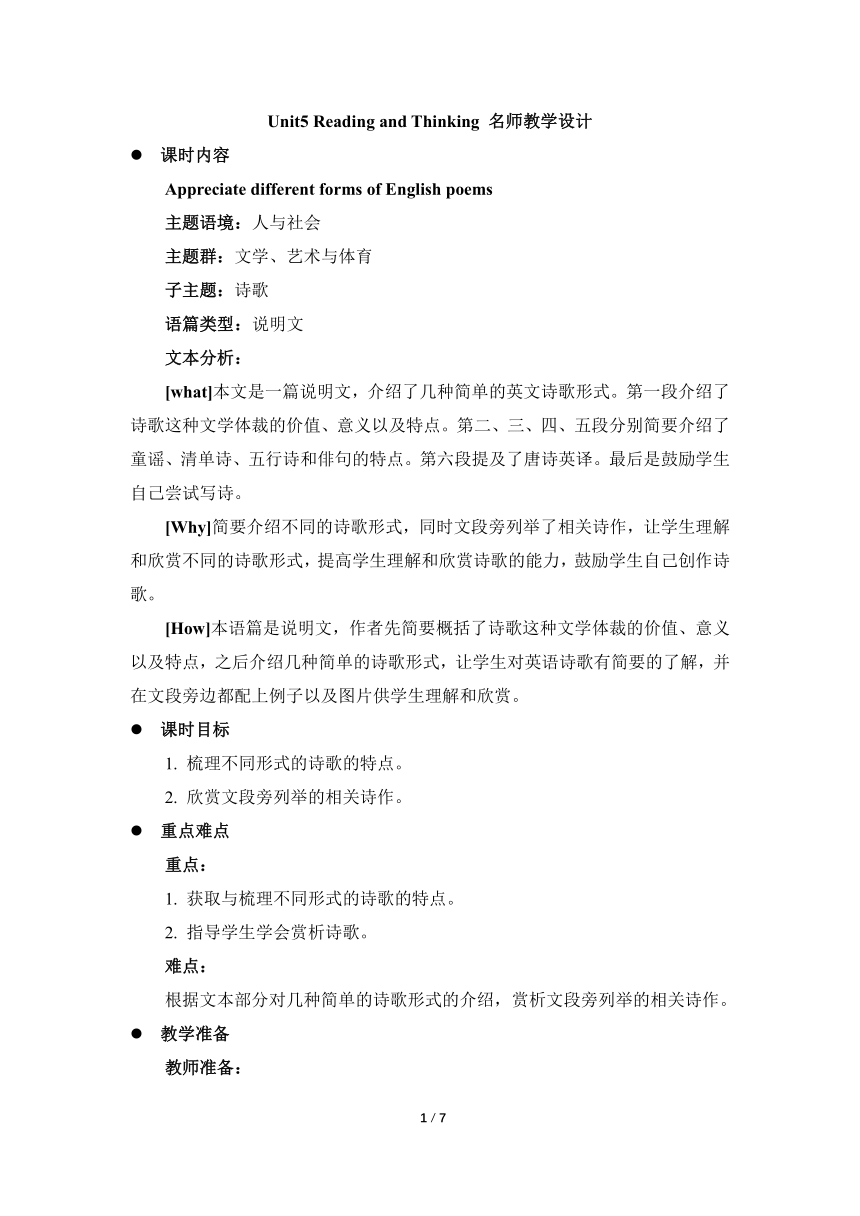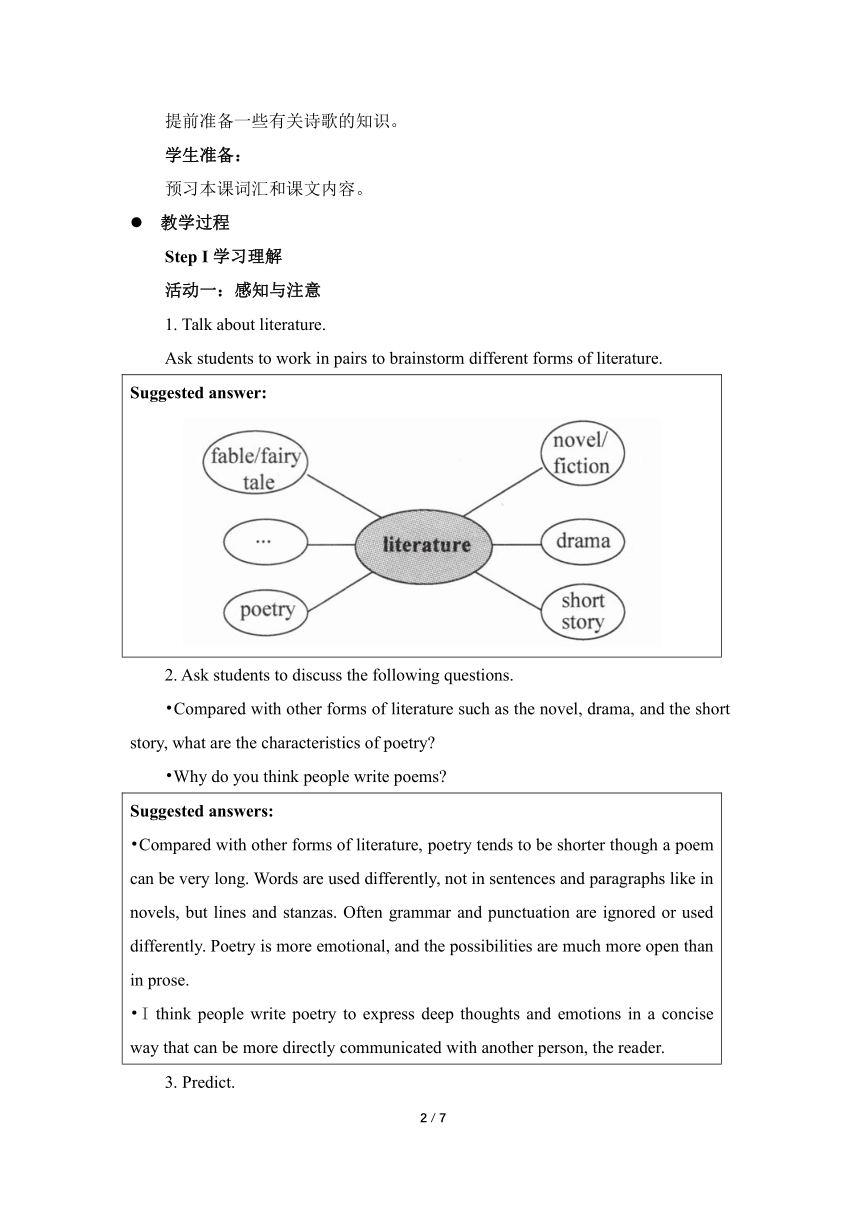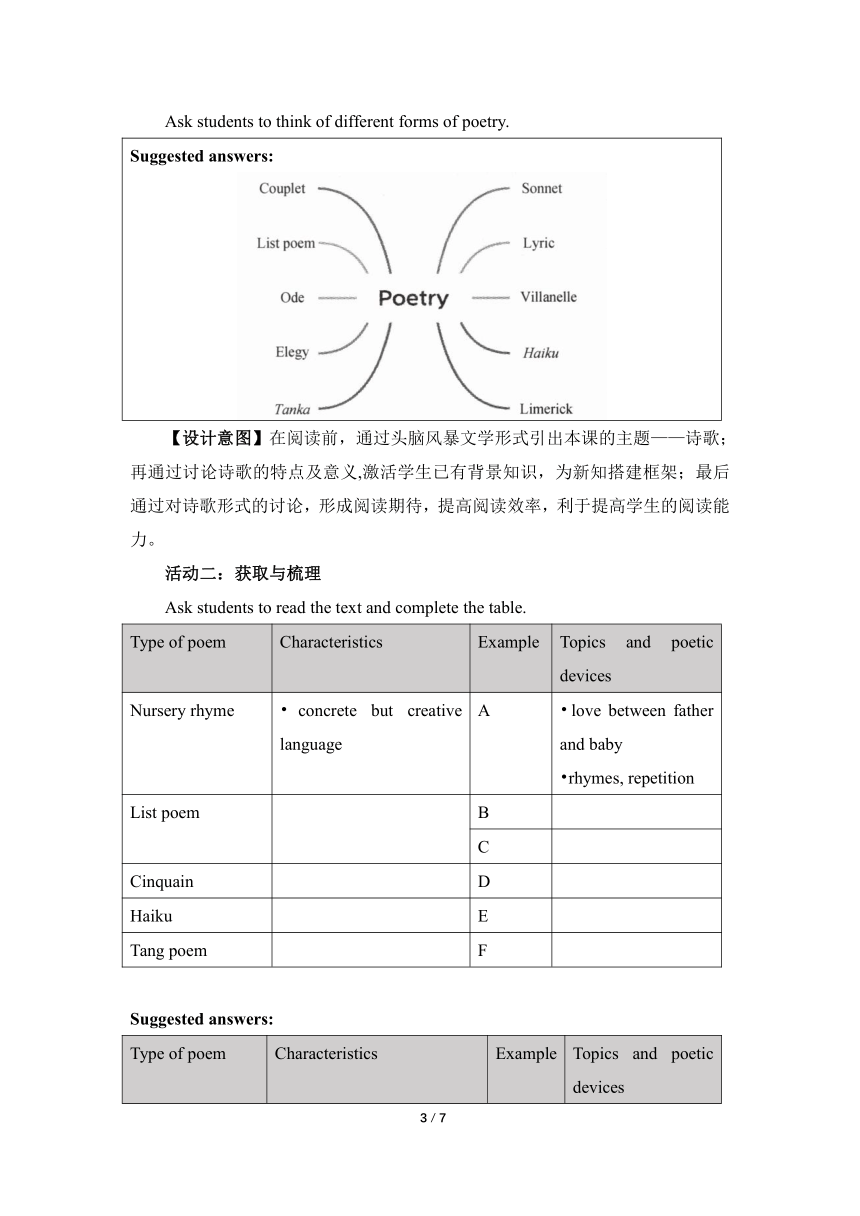人教版(2019)选择性必修第三册 Unit5 Poems Reading and Thinking 名师教学设计
文档属性
| 名称 | 人教版(2019)选择性必修第三册 Unit5 Poems Reading and Thinking 名师教学设计 |

|
|
| 格式 | docx | ||
| 文件大小 | 460.5KB | ||
| 资源类型 | 教案 | ||
| 版本资源 | 人教版(2019) | ||
| 科目 | 英语 | ||
| 更新时间 | 2023-03-13 22:34:14 | ||
图片预览



文档简介
Unit5 Reading and Thinking 名师教学设计
课时内容
Appreciate different forms of English poems
主题语境:人与社会
主题群:文学、艺术与体育
子主题:诗歌
语篇类型:说明文
文本分析:
[what]本文是一篇说明文,介绍了几种简单的英文诗歌形式。第一段介绍了诗歌这种文学体裁的价值、意义以及特点。第二、三、四、五段分别简要介绍了童谣、清单诗、五行诗和俳句的特点。第六段提及了唐诗英译。最后是鼓励学生自己尝试写诗。
[Why]简要介绍不同的诗歌形式,同时文段旁列举了相关诗作,让学生理解和欣赏不同的诗歌形式,提高学生理解和欣赏诗歌的能力,鼓励学生自己创作诗歌。
[How]本语篇是说明文,作者先简要概括了诗歌这种文学体裁的价值、意义以及特点,之后介绍几种简单的诗歌形式,让学生对英语诗歌有简要的了解,并在文段旁边都配上例子以及图片供学生理解和欣赏。
课时目标
1. 梳理不同形式的诗歌的特点。
2. 欣赏文段旁列举的相关诗作。
重点难点
重点:
1. 获取与梳理不同形式的诗歌的特点。
2. 指导学生学会赏析诗歌。
难点:
根据文本部分对几种简单的诗歌形式的介绍,赏析文段旁列举的相关诗作。
教学准备
教师准备:
提前准备一些有关诗歌的知识。
学生准备:
预习本课词汇和课文内容。
教学过程
Step I学习理解
活动一:感知与注意
1. Talk about literature.
Ask students to work in pairs to brainstorm different forms of literature.
Suggested answer:
2. Ask students to discuss the following questions.
Compared with other forms of literature such as the novel, drama, and the short story, what are the characteristics of poetry
Why do you think people write poems
Suggested answers: Compared with other forms of literature, poetry tends to be shorter though a poem can be very long. Words are used differently, not in sentences and paragraphs like in novels, but lines and stanzas. Often grammar and punctuation are ignored or used differently. Poetry is more emotional, and the possibilities are much more open than in prose. I think people write poetry to express deep thoughts and emotions in a concise way that can be more directly communicated with another person, the reader.
3. Predict.
Ask students to think of different forms of poetry.
Suggested answers:
【设计意图】在阅读前,通过头脑风暴文学形式引出本课的主题——诗歌;再通过讨论诗歌的特点及意义,激活学生已有背景知识,为新知搭建框架;最后通过对诗歌形式的讨论,形成阅读期待,提高阅读效率,利于提高学生的阅读能力。
活动二:获取与梳理
Ask students to read the text and complete the table.
Type of poem Characteristics Example Topics and poetic devices
Nursery rhyme concrete but creative language A love between father and baby rhymes, repetition
List poem B
C
Cinquain D
Haiku E
Tang poem F
Suggested answers:
Type of poem Characteristics Example Topics and poetic devices
Nursery rhyme concrete but creative language A love between father and baby rhymes, repetition
List poem lists of things, people, ideas, or descriptions of a particular theme flexible line length repeated phrases for patterns and rhythm B ·nature ·repetition
C ·life ·repetition
Cinquain simple form five lines D brother strong picture or mood
Haiku 17 syllables three lines containing 5, 7, and 5 syllables respectively E nature
Tang poem structured F waiting
【设计意图】将不同的诗歌形式用表格列出,通过根据文本内容填表,让学生更清晰地梳理诗歌不同形式的特点、主题以及修辞手法。
Step II应用实践
活动三:描述与阐释
Appreciate the poems.
(1) Ask students to read the “Poetry comprehension”.
Poetry comprehension Poems paint pictures with words through the use of figures of speech and metaphors, so to understand a poem fully, you have to imagine in your mind the picture the poem is painting. Further, the sounds, rhythm, and rhymes in a poem give it a musical quality. Poems often have to be read aloud, and with feeling, to be really understood and enjoyed.
(2) Show students some background information about the poems in the text.
Background information: A There are a multitude of different versions of the poem. It has a simple structure consisting of a series of rhyming couplets, where a gift is given to the little baby. In the next couplet, the gift is found faulty in some way, and a new gift is presented. The poem continues in this pattern as long as the poet likes; and can come up with new gifts that fit the rhyming pattern. B George Cooper (1840~1927) was an American poet, known particularly for his song lyrics. E It’s a version of a haiku poem by the Japanese poet, Arakida Moritake(荒木田守武,1473~1549). He was a Japanese poet who excelled in the fields of waka, renga, and in particular haiku. At the age of 69,he became head priest of the Inner Ise Shrine. F 望夫石 王建 望夫处,江悠悠。 化为石,不回头。 山头日日风复雨, 行人归来石应语。 王建(约767~830),字仲初,许州(现河南省许昌市)人,唐朝诗人。他的诗题材广泛,思想深刻,多反映社会生活和人民疾苦。名篇有《田家行》《水夫谣》《羽林行》《射虎行》《古从军》《渡辽水》《田家留客》《望夫石》等。 这首诗是诗人王建居于武昌时根据当地传说以及望夫石石像所作的一首诗。从艺术手法上看,这首诗始终抓住石之形与人之情来写,构思很精巧。“望夫处,江悠悠”交代了地点,又以悠悠江水暗喻时间之长,感情之久。“化为石,不回头”言望夫之妇化而为石,也暗示时久。妇人伫立江边,看那江水一去不回头,自己也化为石像永远不回头。“山头日日风复雨”表达不畏风吹雨打,不怕天长日久,她一直不回头,一心望夫归。最后,以“行人归来石应语”结束全诗,又将望夫石拟人化,可谓匠心独运。
(3) Play the recording of the text and ask students to listen carefully.
(4) Ask students to read aloud the poems together.
(5) Invite some students to read the poems in class.
【设计意图】在学习理解类活动的基础上,引导学生对课文中给出的诗进行深层探讨,提高学生的诗歌鉴赏能力。
Step III 迁移创新
活动四:推理与论证
Group work.
Ask students to search the Internet and find another example, which they like the best,of the different types of poem in the text and share it with the class.
【设计意图】学生利用所学诗歌知识,在网上搜索自己喜欢的诗歌并分享给全班,提高学生的诗歌鉴赏能力,实现深度学习,促进能力向素养的转化。
板书设计
Unit 5 Poems Period I Reading and Thinking Ⅰ. 学习理解 活动一:感知与注意 1. Talk about literature. 2. Discuss questions. 3. Predict. 活动二:获取与梳理 Read and complete the table. Ⅱ. 应用实践 活动三:描述与阐释 Appreciate the poems. Ⅲ. 迁移创新 活动四:推理与论证Group work.
2 / 2
课时内容
Appreciate different forms of English poems
主题语境:人与社会
主题群:文学、艺术与体育
子主题:诗歌
语篇类型:说明文
文本分析:
[what]本文是一篇说明文,介绍了几种简单的英文诗歌形式。第一段介绍了诗歌这种文学体裁的价值、意义以及特点。第二、三、四、五段分别简要介绍了童谣、清单诗、五行诗和俳句的特点。第六段提及了唐诗英译。最后是鼓励学生自己尝试写诗。
[Why]简要介绍不同的诗歌形式,同时文段旁列举了相关诗作,让学生理解和欣赏不同的诗歌形式,提高学生理解和欣赏诗歌的能力,鼓励学生自己创作诗歌。
[How]本语篇是说明文,作者先简要概括了诗歌这种文学体裁的价值、意义以及特点,之后介绍几种简单的诗歌形式,让学生对英语诗歌有简要的了解,并在文段旁边都配上例子以及图片供学生理解和欣赏。
课时目标
1. 梳理不同形式的诗歌的特点。
2. 欣赏文段旁列举的相关诗作。
重点难点
重点:
1. 获取与梳理不同形式的诗歌的特点。
2. 指导学生学会赏析诗歌。
难点:
根据文本部分对几种简单的诗歌形式的介绍,赏析文段旁列举的相关诗作。
教学准备
教师准备:
提前准备一些有关诗歌的知识。
学生准备:
预习本课词汇和课文内容。
教学过程
Step I学习理解
活动一:感知与注意
1. Talk about literature.
Ask students to work in pairs to brainstorm different forms of literature.
Suggested answer:
2. Ask students to discuss the following questions.
Compared with other forms of literature such as the novel, drama, and the short story, what are the characteristics of poetry
Why do you think people write poems
Suggested answers: Compared with other forms of literature, poetry tends to be shorter though a poem can be very long. Words are used differently, not in sentences and paragraphs like in novels, but lines and stanzas. Often grammar and punctuation are ignored or used differently. Poetry is more emotional, and the possibilities are much more open than in prose. I think people write poetry to express deep thoughts and emotions in a concise way that can be more directly communicated with another person, the reader.
3. Predict.
Ask students to think of different forms of poetry.
Suggested answers:
【设计意图】在阅读前,通过头脑风暴文学形式引出本课的主题——诗歌;再通过讨论诗歌的特点及意义,激活学生已有背景知识,为新知搭建框架;最后通过对诗歌形式的讨论,形成阅读期待,提高阅读效率,利于提高学生的阅读能力。
活动二:获取与梳理
Ask students to read the text and complete the table.
Type of poem Characteristics Example Topics and poetic devices
Nursery rhyme concrete but creative language A love between father and baby rhymes, repetition
List poem B
C
Cinquain D
Haiku E
Tang poem F
Suggested answers:
Type of poem Characteristics Example Topics and poetic devices
Nursery rhyme concrete but creative language A love between father and baby rhymes, repetition
List poem lists of things, people, ideas, or descriptions of a particular theme flexible line length repeated phrases for patterns and rhythm B ·nature ·repetition
C ·life ·repetition
Cinquain simple form five lines D brother strong picture or mood
Haiku 17 syllables three lines containing 5, 7, and 5 syllables respectively E nature
Tang poem structured F waiting
【设计意图】将不同的诗歌形式用表格列出,通过根据文本内容填表,让学生更清晰地梳理诗歌不同形式的特点、主题以及修辞手法。
Step II应用实践
活动三:描述与阐释
Appreciate the poems.
(1) Ask students to read the “Poetry comprehension”.
Poetry comprehension Poems paint pictures with words through the use of figures of speech and metaphors, so to understand a poem fully, you have to imagine in your mind the picture the poem is painting. Further, the sounds, rhythm, and rhymes in a poem give it a musical quality. Poems often have to be read aloud, and with feeling, to be really understood and enjoyed.
(2) Show students some background information about the poems in the text.
Background information: A There are a multitude of different versions of the poem. It has a simple structure consisting of a series of rhyming couplets, where a gift is given to the little baby. In the next couplet, the gift is found faulty in some way, and a new gift is presented. The poem continues in this pattern as long as the poet likes; and can come up with new gifts that fit the rhyming pattern. B George Cooper (1840~1927) was an American poet, known particularly for his song lyrics. E It’s a version of a haiku poem by the Japanese poet, Arakida Moritake(荒木田守武,1473~1549). He was a Japanese poet who excelled in the fields of waka, renga, and in particular haiku. At the age of 69,he became head priest of the Inner Ise Shrine. F 望夫石 王建 望夫处,江悠悠。 化为石,不回头。 山头日日风复雨, 行人归来石应语。 王建(约767~830),字仲初,许州(现河南省许昌市)人,唐朝诗人。他的诗题材广泛,思想深刻,多反映社会生活和人民疾苦。名篇有《田家行》《水夫谣》《羽林行》《射虎行》《古从军》《渡辽水》《田家留客》《望夫石》等。 这首诗是诗人王建居于武昌时根据当地传说以及望夫石石像所作的一首诗。从艺术手法上看,这首诗始终抓住石之形与人之情来写,构思很精巧。“望夫处,江悠悠”交代了地点,又以悠悠江水暗喻时间之长,感情之久。“化为石,不回头”言望夫之妇化而为石,也暗示时久。妇人伫立江边,看那江水一去不回头,自己也化为石像永远不回头。“山头日日风复雨”表达不畏风吹雨打,不怕天长日久,她一直不回头,一心望夫归。最后,以“行人归来石应语”结束全诗,又将望夫石拟人化,可谓匠心独运。
(3) Play the recording of the text and ask students to listen carefully.
(4) Ask students to read aloud the poems together.
(5) Invite some students to read the poems in class.
【设计意图】在学习理解类活动的基础上,引导学生对课文中给出的诗进行深层探讨,提高学生的诗歌鉴赏能力。
Step III 迁移创新
活动四:推理与论证
Group work.
Ask students to search the Internet and find another example, which they like the best,of the different types of poem in the text and share it with the class.
【设计意图】学生利用所学诗歌知识,在网上搜索自己喜欢的诗歌并分享给全班,提高学生的诗歌鉴赏能力,实现深度学习,促进能力向素养的转化。
板书设计
Unit 5 Poems Period I Reading and Thinking Ⅰ. 学习理解 活动一:感知与注意 1. Talk about literature. 2. Discuss questions. 3. Predict. 活动二:获取与梳理 Read and complete the table. Ⅱ. 应用实践 活动三:描述与阐释 Appreciate the poems. Ⅲ. 迁移创新 活动四:推理与论证Group work.
2 / 2
